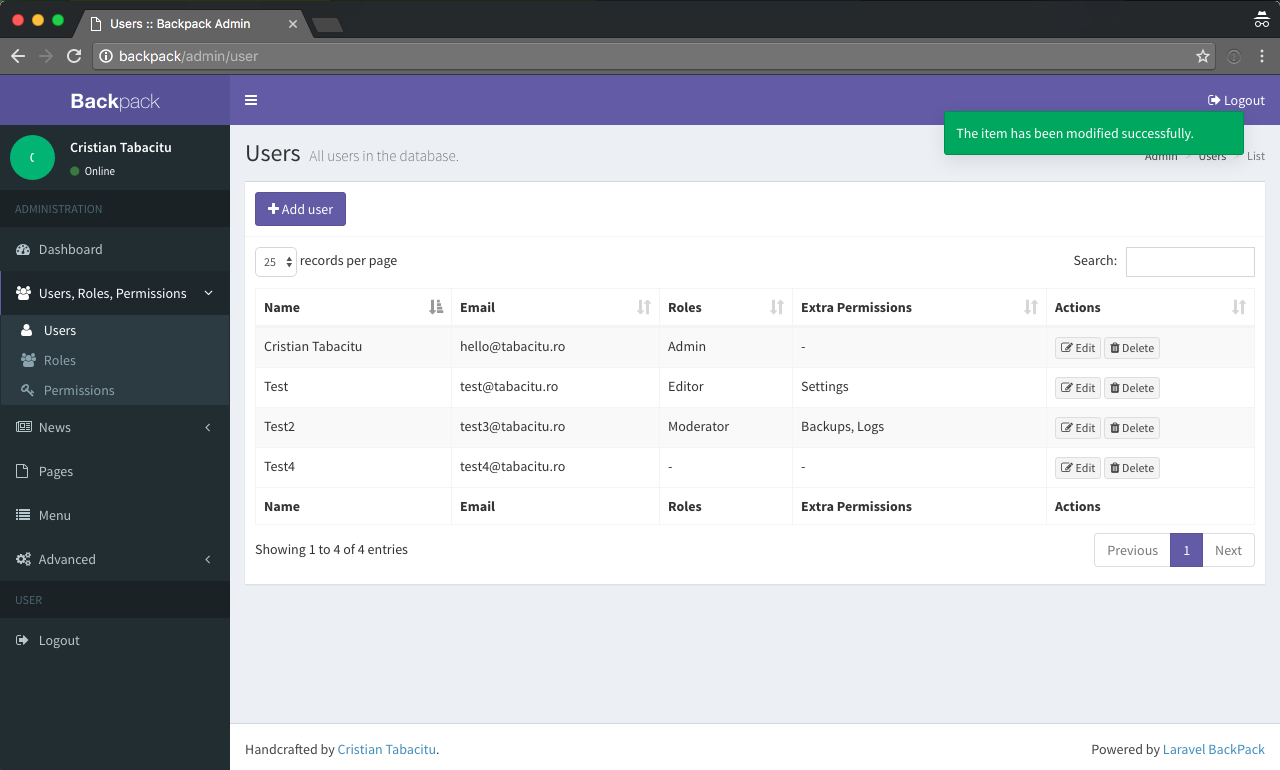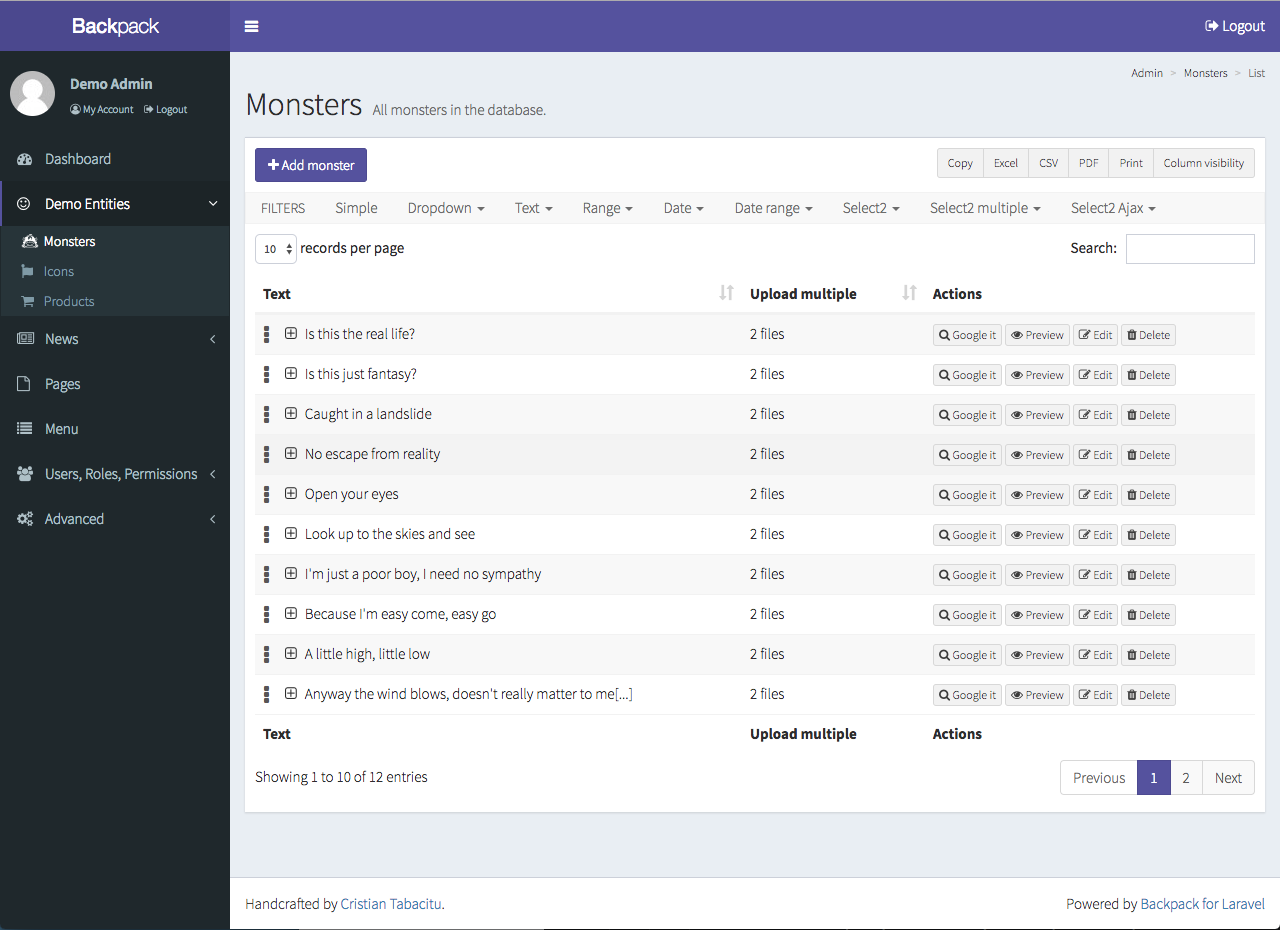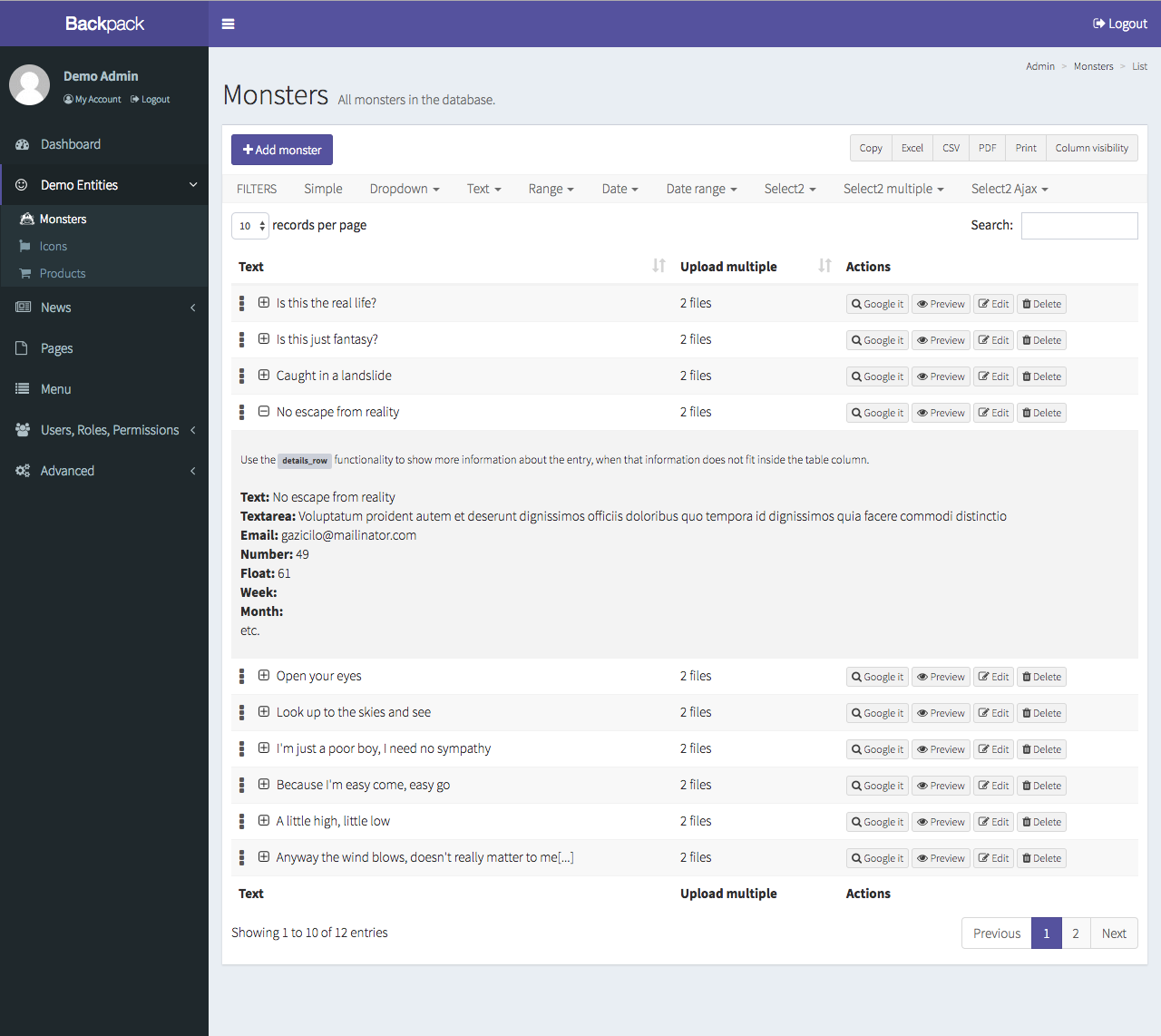ListEntries
About
This operation shows a table with all database entries. It's the first page the admin lands on (for an entity), and it's usually the gateway to all other operations, because it holds all the buttons.
A simple ListEntries view might look like this:

But a complex implementation of the ListEntries operation, using Columns, Filters, custom Buttons, custom Operations, responsive table, Details Row, Export Buttons will still look pretty good:

You can easily customize columns, buttons, filters, enable/disable additional features we've built, or overwrite the view and build your own features.
How It Works
The main route leads to EntityCrudController::index(), which shows the table view (list.blade.php. Inside that table view, we're using AJAX to fetch the entries and place them inside DataTables. That AJAX points to the same controller, EntityCrudController::search().
Actions:
index()search()
For views, it uses:
list.blade.phpcolumns/buttons/
How to Use
The ListEntries operation is enabled by default. To disable it, you can use $this->crud->denyAccess('list'); inside your setup() method.
Configuration for this operation is usually done inside your setup() method. That's recommended, because the columns you define here are used by a few actions (index(), search(), show()).
For a minimum setup, you only need to define the columns you need to show in the table.
Columns
Columns represent the way your information is shown in the table view. All column types must have their name, label and type specified, but some could require some other attributes too.
$this->crud->addColumn([
'name' => 'name', // The db column name
'label' => "Tag Name", // Table column heading
'type' => 'Text'
]);Backpack has 22+ column types you can use. Plus, you can easily create your own type of column. Check out the Columns documentation page for a detailed look at column types, API and usage.
Buttons
Buttons are used to trigger other operations. Some point to entirely new routes (create, update, show), others perform the operation on the current page using AJAX (delete).
The ShowList operation has 3 places where buttons can be placed:
top(where the Add button is)line(where the Edit and Delete buttons are)bottom(after the table)
Backpack adds a few buttons by default:
addto thetopstack;editanddeleteto thelinestack;
To learn more about buttons, check out the Buttons documentation page.
Filters
Filters show up right before the actual table, and provide a way for the admin to filter the results in the ListEntries table. To learn more about filters, check out the Filters documentation page.
Other Features
Details Row
The details row functionality allows you to present more information in the table view of a CRUD. When enabled, a "+" button will show up next to every row, which on click will expand a "details row" below it, showing additional information.

On click, an AJAX request is sent to the entity/{id}/details route, which calls the showDetailsRow() method on your EntityCrudController. Everything returned by that method is then shown in the details row. You'll want to overwrite that method to show anything you'd like in the details row.
To use, inside your EntityCrudController:
- Enable the functionality:
$this->crud->enableDetailsRow(); - Allow access to all admins:
$this->crud->allowAccess('details_row');; Wrap an "if" statement around this if you don't want everybody to be able to see it. - Overwrite the
showDetailsRow($id)method;
Alternative for the 3rd step: overwrite views/backpack/crud/details_row.blade.php which is called by the default showDetailsRow($id) functionality.
Export Buttons
Exporting the DataTable to PDF, CSV, XLS is as easy as typing $this->crud->enableExportButtons(); in your constructor.

Please note that when clicked, each button will export the currently visible table. You can use the "visibility" button, and the "Items per page" dropdown to manipulate what is inside the export.
Custom Query
By default, all entries are shown in the ListEntries table, before filtering. If you want to restrict the entries to a subset, you can use the methods below in your EntityCrudController's setup() method:
// Change what entries are shown in the table view.
// This changes all queries on the table view,
// as opposed to filters, who only change it when that filter is applied.
$this->crud->addClause('active'); // apply a local scope
$this->crud->addClause('type', 'car'); // apply local dynamic scope
$this->crud->addClause('where', 'name', '=', 'car');
$this->crud->addClause('whereName', 'car');
$this->crud->addClause('whereHas', 'posts', function($query) {
$query->activePosts();
});
$this->crud->groupBy();
$this->crud->limit();
$this->crud->orderBy();
// please note it's generally a good idea to use crud->orderBy() inside "if (!$this->request->has('order')) {}"; that way, your custom order is applied ONLY IF the user hasn't forced another order (by clicking a column heading)Responsive Table
If your CRUD table has more columns than can fit inside the viewport (on mobile / tablet or smaller desktop screens), unimportant columns will start hiding and an expansion icon (three dots) will appear to the left of each row. We call this behaviour "responsive table", and consider this to be the best UX. By behaviour we consider the 1st column the most important, then 2nd, then 3rd, etc; the "actions" column is considered as important as the 1st column. You can of course change the importance of columns.
If you do not like this, you can toggle off the responsive behaviour for all CRUD tables by changing this config value in your config/backpack/crud.php to false:
// enable the datatables-responsive plugin, which hides columns if they don't fit?
// if not, a horizontal scrollbar will be shown instead
'responsive_table' => trueTo turn off the responsive table behaviour for just one CRUD panel, you can use $this->crud->disableResponsiveTable() in your setup() method.
Persistent Table
By default, ListEntries will NOT remember your filtering, search and pagination when you leave the page. If you want ListEntries to do that, you can enable a ListEntries feature we call persistent_table.
This will take the user back to the filtered table after adding an item, previewing an item, creating an item or just browsing around, preserving the table just like he/she left it - with the same filtering, pagination and search applied. It does so by saving the pagination, search and filtering for 2 hours in local storage.
To use persistent_table you can:
- enable it for all CRUDs with the config option
'persistent_table' => truein yourconfig/backpack/crud.php; - enable it inside a particular crud controller with
$this->crud->enablePersistentTable(); - disable it inside a particular crud controller with
$this->crud->disablePersistentTable();
How to Overwrite
The main route leads to EntityCrudController::index(), which loads list.blade.php. Inside that table view, we're using AJAX to fetch the entries and place them inside a DataTables. The AJAX points to the same controller, EntityCrudController::search().
The View
You can change how the list.blade.php file looks and works, by just placing a file with the same name in your resources/views/vendor/backpack/crud/list.blade.php. To quickly do that, run:
php artisan backpack:crud:publish listKeep in mind that by publishing this file, you won't be getting any updates we'll be pushing to it.
The Operation Logic
Getting and showing the information is done inside the index() method. Take a look at the CrudController::index() method (your EntityCrudController is extending this CrudController) to see how it works.
To overwrite it, just create an index() method in your EntityCrudController.
The Search Logic
An AJAX call is made to the search() method:
- when entries are shown in the table;
- when entries are filtered in the table;
- when search is performed on the table;
- when pagination is performed on the table;
You can of course overwrite this search() method by just creating one with the same name in your EntityCrudController. In addition, you can overwrite what a specific column is searching through (and how), by using the searchLogic attribute on columns.